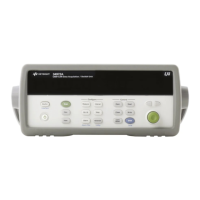7Tutorial
308 Keysight 34970A/34972A User’s Guide
High-Resistance Measurement Errors
When you are measuring large resistances, significant errors can occur due to
insulation resistance and surface cleanliness. You should take the necessary
precautions to maintain a “clean” high-resistance system. Test leads and fixtures
are susceptible to leakage due to moisture absorption in insulating materials and
“dirty” surface films. Nylon and PVC are relatively poor insulators (10
9
ohms) when
compared to PTFE Teflon insulators (10
13
ohms). Leakage from nylon or PVC
insulators can easily contribute a 0.1% error when measuring a 1 MΩ resistance in
humid conditions. The table below shows several common insulating materials
and their typical resistances.
Strain Gage Measurements
Although the instrument does not directly support strain measurements, you can
measure a strain gage using a 4-wire resistance measurement with scaling.
However, BenchLink Data Logger 3 software has built-in strain gage
measurement capability.
When a force is applied to a body, the body deforms. The deformation per unit
length is called strain (ε). Strain may be either tensile (+) or compressive (-).
Practical strain values are usually quite small (typically less than 0.005 inch/inch
for most metals) and are often expressed in micro-strains (με). There are three
common types of strain measurements as shown below.
Insulating Material Resistance Range Moisture Absorbing
Teflon (PTFE)
Nylon
PVC
Polystyrene
Ceramic
Glass Epoxy (FR-4, G-10)
Phenolic, Paper
1 TΩ to 1 PΩ
1 GΩ to 10 TΩ
10 GΩ to 10 TΩ
100 GΩ to 1 PΩ
1 GΩ to 1 PΩ
1 GΩ to 10 TΩ
10 MΩ to 10 GΩ
N
Y
Y
N
N
Y
Y

